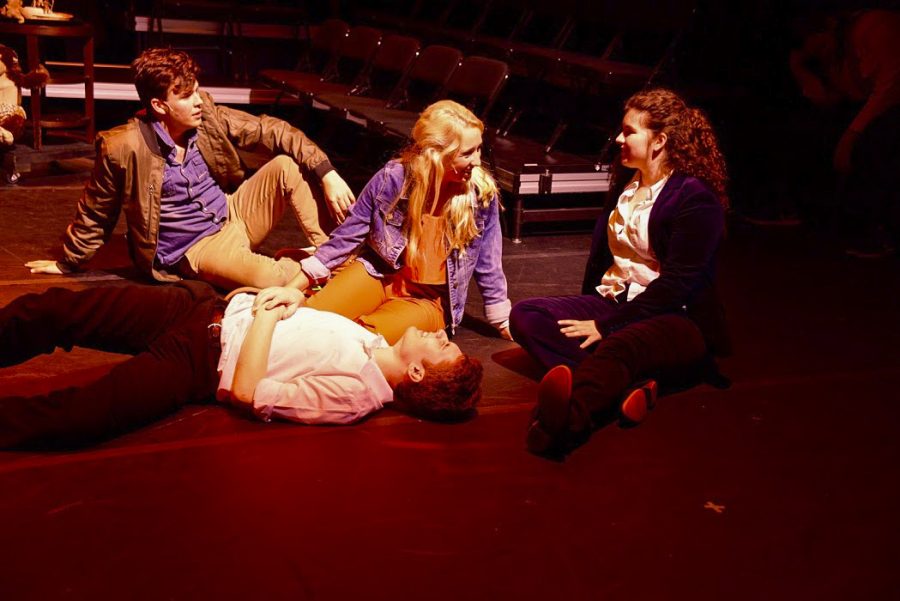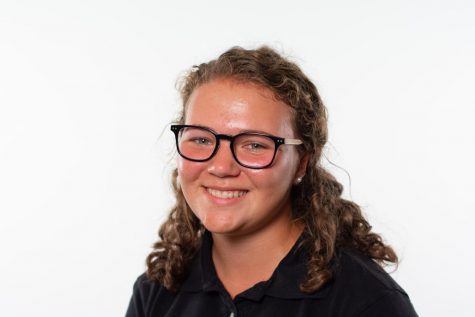Four friends embarking on one unconventional journey through past, present and future are stepping into a new spotlight. The Trinity production of “Now. Here. This.” marks the first time ever for both actors and author that the Off-Broadway hit was performed by high school actors. This innovative production taken on by Trinity’s Musical Theater class was also witnessed by its co-author, Susan Blackwell, in addition to the part she played in the Visiting Writers program.
“Now. Here. This.” has been performed by professional companies since 2012, but with the addition of a high school ensemble were many new aspects introduced to cater to the audience and the actors. Directing the performance was Fine Arts Chair Janine Papin, who soon realized there would be new obstacles to overcome with her high school cast.
“The show was written for four people,” Papin said. “I have ten people in my [Musical Theater] class. In order to accommodate the extra people, I have had to invent a way to stage it and still stay true to the script.”
These four characters were divided between the members of the Musical Theater class, with two double casted male characters and two triple casted female characters. Another change to the original production was made to the sets. Actors performed the musical in the round, surrounding themselves not only with the setting of the story but also with the audience, who viewed the production from all sides.
Freshman Thomas Lightsey, who played the character of Man Two, noted the differences and challenges of the round, but he also found that it made it “a very personal show.”
“We’ve got people on all four sides of us instead of the traditional stage just facing one way,” Lightsey said. “So when you’re doing a monologue, you have to face all sides of the audience.”
To add to the normal stress and excitement that comes as a product of any new musical, the actors had to account for the presence of the production’s co-author, who joined classes and audiences to witness the high school premier of her work.
Senior Hannah Mosher particularly felt the apprehension of the author’s coming because of her role in the production.
“It’s so scary,” Mosher said. “I’m Woman One, and Susan Blackwell, who wrote the musical and [came] to see it, was also Woman One in the original Off-Broadway performance.”
Papin showed none of the nerves her students did and eagerly awaited the moment when she could once again work with Blackwell, especially in the given setting.
“I am super excited!” Papin said. “I met Susan Blackwell years ago while doing professional development workshops in N.Y.C. Since then I have had the privilege of doing many workshops with her. On my trips to New York with Trinity Prep students, she has led workshops for them … that have been among the best experiences I have had.”
The performance of “Now. Here. This.” proved to be a new experience for all of the participants in more than one way. Unlike many traditional musicals, “Now. Here. This.” took a completely different path in a direction that many in the performing arts had not yet explored.
“The show does not tell a linear story,” Papin said. “Four friends, attempting to spend some time together, visit a museum. The museum exhibits trigger memories of the past. Each person revisits the past and the experiences that have influenced and shaped the person that they have become.”
Because of the small cast and deep explanations of events, the actors that were a part of “Now. Here. This.” found that the characters themselves were one of the greatest challenges of the production. Most of their work was focused on capturing the reality and vulnerability of the exceedingly human characters.
“Another thing that’s different about this show is that they’re not the typical characters,” Mosher said. “It’s a whole different personality of a real person who is just living their life. It’s hard to remain real but be someone completely different and also personally connect to everything.”
The difficulties stemmed from the incredibly real problems and personalities of the characters, and the actors had to learn new techniques to capture the nature of the characters they portray.
“In the past I’ve had over the top character roles, but this is a character that is based on someone’s actual life so you really don’t want to make it a ‘character,’” Lightsey said. “I try to take the life experiences that this person had and relate my life to them.”
One common question that arose upon first glance at the production was the meaning of the title. Though interpretations can vary, Papin took a historical point of view on the explanation of “Now. Here. This.”
“The Jesuit priest Thomas Merton believed that if you can get to the intersection of Now (not the past or the future), Here (exactly where you are), and This (whatever it is you are doing), then there is nothing to fear,” Papin said. “You will be free to truly appreciate your life. The musical is all about finding ‘the moment’ when the friends can connect, be present and fully appreciate the time that they have together. This is something that I know each and every one of us struggles with.”
“Now. Here. This.” used its own innovative structure and unconventional story to connect audiences to both each other and the present. As these four friends related their lives and struggles, the musical opened new doors to a better understanding of what it means to live in the now.
“Each character has their own message,” Mosher said, “But overall I think instead of running away from your past or trying to create something out of your future that you don’t want it to be, you should try to be the best you that you can be right now.”




